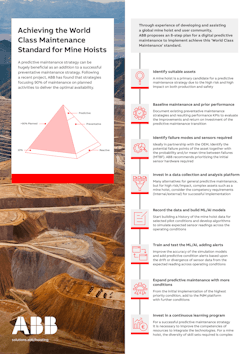Maintenance Mindset: Manufacturing defect causes wind turbine failure
Welcome to Maintenance Mindset, our editors’ takes on things going on in the worlds of manufacturing and asset management that deserve some extra attention. This will appear regularly in the Member’s Only section of the site.
Report: Predictive maintenance strategies in the mining industry
ABB has released an interesting report and infographic that focus on the value of predictive maintenance in the mining sector, specifically on maintenance of hoisting equipment.
The key takeaway in the report is that, on average, mining companies have the potential to achieve more than a month of additional production time annually by following recommended predictive maintenance strategies, in addition to preventive and reactive work. ABB has summarized their findings in this infographic, which presents an 8-step plan for a digital predictive maintenance.
The mining industry is facing a new challenge to increase productivity. As ore grades in established sites become depleted while demand for resources grows, the industry has been shifting to deeper mining to reach these critical resources, with mine hoists offering the most efficient way to transport heavy loads of ore from the depths. The ABB benchmarking survey into hoisting maintenance focused on how mining companies might operate at the highest possible levels of reliability and productivity.
The report also highlighted that mining companies using reactive maintenance could make up a gap of around 15 percent in availability compared with companies that already following more proactive approaches (i.e., preventive and predictive). Those faced with the highest levels of availability loss had, on average, dedicated less of their maintenance strategy to proactive approach versus reactive (75 percent and 25 percent retrospectively).
In other findings, ABB identified a need for greater standardization and insight regarding optimal maintenance strategies to help its customers keep mine hoists running. While periodic maintenance has been implemented across hoist systems, continuous monitoring and assessment were much further behind. Of those surveyed, only 16 percent had applied continuous predictive monitoring to their mechanical systems.
– Thomas Wilk
Made-in-America semiconductors in deep water
America’s growing interest in bringing the manufacture of goods back to domestic facilities took center stage when COVID-19 brought the global supply chain to a grinding halt. The flaws in our global economy became glaringly clear, and none more so than in semiconductor manufacturing. We depend on these tiny integrated circuits for our most precious electronic devices. And what’s more American than cars, whose sales plummeted at the height of the chip shortage. In general, manufacturing and industrial automation markets were hit hard all over, but for the most part semiconductor supply chains have seen relief.
In August 2022, the Biden Administration introduced the Creating Helpful Incentives to Produce Semiconductors (CHIPS) and Science Act to invest $53B in U.S. semiconductor manufacturing. A year later, the administration reported that $166B of private investment had joined those federal dollars to lessen our dependence on global chip giants like China and South Korea. Sweet Land of Liberty!
Many of those fab projects are becoming a reality quickly. In May 2020, Taiwan Semiconductor Manufacturing Co. (TSMC), one of the largest chip manufacturers, had already planned to invest $12B at a Phoenix, Arizona facility, and it received another $6.6B in CHIPS funding earlier this year in April to focus on production of the most advanced microchips. Made in America!
That’s investment for just one company—nearly $19B—and production at TSMC’s first fab in Arizona is on track to begin production the first half of 2025. That’s fast moving for a government funded project. U.S.A! U.S.A! America is on a mission to rock and roll domestic chip production—no holds barred—
Oh, wait a second. Hold your digital horses. Semiconductor manufacturing also consumes enormous quantities of water, and many production facilities have made their new home in the water-needy Phoenix area.
Chip manufacturing not only needs water, but the process also needs ultrapure water, which is 10,000 times cleaner than drinking water and is treated through deionization and reverse osmosis to remove impurities that can damage chips. It takes roughly 1,400 to 1,600 gallons of municipal water to make 1,000 gallons of ultrapure water. An average chip manufacturing facility can use 10 million gallons of ultrapure water per day, which equals on average the amount of water used daily by 33,000 U.S. households. The scarcity of water, particularly in states like Arizona and the future effects of climate change on water resources, combined with the escalating global demand for advanced tech and semiconductors, presents a potential supply chain issue on a whole different level.
Darn it. Why can’t shifting the entire global marketplace be easier? Well, not all is lost. These big chip manufacturers aren’t oblivious to the water risks of the future, and they have plans. The new TSMC fab opening in 2025 has plans to reclaim 65% of the water it uses, to reduce dependence on city water.
Intel also received CHIPS funding and is building two fabs in Arizona. The company has also entered into an agreement with the City of Chandler to build a reclaimed water facility. Both will split the $45 million construction cost. And many other tech companies (Sony, Microsoft, Apple, Amazon) are including water goals in their sustainability initiatives.
We often don’t think of the sustainability implications of advanced technology. What’s the water cost to manufacture the chips that will power the growing use of artificial intelligence in the future? Will we use AI to monitor, allocate and optimize the water supply? Is that a Catch-22 for chip sustainability?
Kirsten James, senior program director at Ceres, an environmental nonprofit advocacy organization, says semiconductor manufacturers can improve water efficiency with better monitoring systems and new tech that requires less water, and tech companies buying chips should have sourcing policies to ensure they buy chips from manufacturers that use water resources wisely. United we stand!
– Anna Townshend
“Manufacturing deviation” to blame for wind turbine failure
It's a bird. It's a plane. It's pieces of a defective wind turbine blade falling out of the sky! That’s what happened at Vineyard Wind, the nation’s first commercial-scale offshore wind project located 15 miles off the coast of Massachusetts. The incident occurred on July 13 when pieces of debris began appearing on the beaches of Nantucket. Luckily, no one was injured, but the Bureau of Safety and Environmental Enforcement issued a Suspension Order that directed Vineyard Wind to “cease power production from all its wind turbine generators until it can be determined whether the blade failure affects any other VW turbines.” Vineyard Wind implemented its pre-established protocols and worked to define a safety perimeter, partnered with the Coast Guard to notify mariners, and began debris recovery efforts.
Vineyard Wind then reached out to GE Vernova, who manufactured and installed the turbines, to conduct a root cause analysis of the incident. So, what really happene?
During its Q2 2024 earnings call on July 24, GE Vernova addressed the situation. Scott Strazik, CEO and Director of the company, said, “With safety always as a top priority, we are working with our customer and the appropriate agencies to determine the root cause and then implement corrective actions and a restart plan. While we continue to work to finalize our root cause analysis, our investigation to date indicates that the affected blade experienced a manufacturing deviation. We have not identified information indicating an engineering design flaw in the blade or information of a connection with the blade event we experienced in an Offshore Wind project in the UK, which was caused by an installation error out at sea.”
Later in the call, Scott answered a question related to the Vineyard Wind incident. He said, “we have no indications of an engineering design flaw - that's important at the beginning. As we said in the prepared remarks, we have identified a material deviation, or a manufacturing deviation, in one of our factories that through the inspection or quality assurance process, we should have identified. Because of that, we're going to use our existing data and reinspect all of the blades that we have made for Offshore wind and for context in this factory in Gaspé, Canada where the material deviation existed, we've made about 150 blades, so that gives you an indication and context of the work ahead. But to be clear, this is work we know how to do. I mean the industry uses non-destructive testing, think ultrasound, think a radiologist, but for a blade to identify deviations. We are going to go and do this on every blade, prudent, thorough process.”
– Alexis Gajewski
About the Author

Thomas Wilk
editor in chief
Thomas Wilk joined Plant Services as editor in chief in 2014. Previously, Wilk was content strategist / mobile media manager at Panduit. Prior to Panduit, Tom was lead editor for Battelle Memorial Institute's Environmental Restoration team, and taught business and technical writing at Ohio State University for eight years. Tom holds a BA from the University of Illinois and an MA from Ohio State University

Anna Townshend
managing editor
Anna Townshend has been a journalist and editor for almost 20 years. She joined Control Design and Plant Services as managing editor in June 2020. Previously, for more than 10 years, she was the editor of Marina Dock Age and International Dredging Review. In addition to writing and editing thousands of articles in her career, she has been an active speaker on industry panels and presentations, as well as host for the Tool Belt and Control Intelligence podcasts. Email her at [email protected].
Alexis Gajewski
Senior Content Strategist
Alexis Gajewski has over 15 years of experience in the maintenance, reliability, operations, and manufacturing space. She joined Plant Services in 2008 and works to bring readers the news, insight, and information they need to make the right decisions for their plants. Alexis also authors “The Lighter Side of Manufacturing,” a blog that highlights the fun and innovative advances in the industrial sector.

